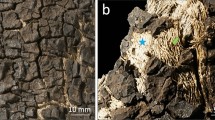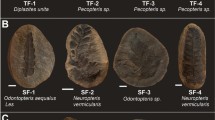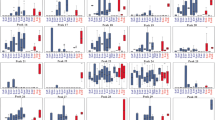Abstract
Fungal stromata were recently discovered in association with charcoal and burnt soil aggregates during an archaeological survey in the Châtillon-sur-Seine forest massif. The wood and soil in the samples were dated to the medieval period (between 738 and 1411 AD). Light microscopy and scanning electron microscopy revealed that a few of the stromatal fragments still contained ascospores. Their macromorphological characters were described and secondary metabolite profiles were generated using high performance liquid chromatography with diode array and mass spectrometric detection (HPLC–DAD/MS). The combination of these two data lines then allowed species identification. Most of the fragments were assigned to Hypoxylon fragiforme, the type species of the Hypoxylaceae (Xylariales). Two further species whose stromata grew on the fossil charcoal could be tentatively identified as Jackrogersella cohaerens and (more tentatively) as Hypoxylon vogesiacum. These three species are still commonly encountered in the forests of Central Europe today. Furthermore, the HPLC-HRMS data of H. fragiforme suggested the presence of unknown azaphilone dimers and of further new pigments. These archaeological compounds were compared to fresh stromata of H. fragiforme collected in Germany and subjected to the same analytical protocol. While the major components in both samples were identified as the known mitorubrin type azaphilones and orsellinic acid, the chemical structures of seven novel complex azaphilone pigments, for which we propose the trivial names rutilins C-D and fragirubrins A-E, were elucidated using spectral methods (NMR and CD spectroscopy, high resolution mass spectrometry). It appears that these pigments had indeed persisted for millennia in the fossil stromata.





Similar content being viewed by others
References
Bitzer J, Köpcke B, Stadler M, Hellwig V, Ju YM, Seip S, Henkel T (2007) Accelerated dereplication of natural products, supported by reference libraries. Chimia 51:332–338
Chapela IH, Petrini O, Bielser G (1993) The physiology of ascospore eclosion in Hypoxylon fragiforme: mechanisms in the early recognition and establishment of an endophytic symbiosis. Mycol Res 97:157–162
Clark RC, Lee SY, Boger DL (2008) Total synthesis of chlorofusin, its seven chromophore diastereomers, and key partial structures. J Am Chem Soc 130:12355–12369
Daranagama DA, Hyde KD, Sir EB, Thambugala KM, Tian Q, Samarakoon MC, McKenzie EHC, Jayasiri SC, Tibpromma S, Bhat JD, Liu X, Stadler M (2018) Towards a natural classification and backbone tree for Graphostromataceae, Hypoxylaceae, Lopadostomataceae and Xylariaceae. Fungal Divers 88:1–165
Divakar PK, Crespo A, Kraichak E, Leavitt SD, Singh G, Schmitt I, Lumbsch HT (2017) Using a temporal phylogenetic method to harmonize family-and genus-level classification in the largest clade of lichen-forming fungi. Fungal Divers 84:101–117
Fournier J, Köpcke B, Stadler M (2010) New species of Hypoxylon from western Europe and Ethiopia. Mycotaxon 113:209–235
Gao J-M, Yang S-X, Qin J-C (2013) Azaphilones: chemistry and Biology. Chem Rev 113:4755–4811
Hashimoto T, Asakawa Y (1998) Biologically active substances of Japanese inedible mushrooms. Heterocycles 2(47):1067–1110
Helaly SE, Thongbai B, Stadler M (2018) Diversity of biologically active secondary metabolites from endophytic and saprotrophic fungi of the ascomycete order Xylariales. Nat Prod Rep. https://doi.org/10.1039/c8np00010g
Hellwig V, Ju Y-M, Rogers JD, Fournier J, Stadler M (2005) Hypomiltin, a novel azaphilone from Hypoxylon hypomiltum, and chemotypes in Hypoxylon sect. Hypoxylon as inferred from analytical HPLC profiling. Mycol Progr 4:39–54
Hongsanan S, Maharachchikumbura SS, Hyde KD, Samarakoon MC, Jeewon R, Zhao Q, Al-Sadi AM, Bahkali AH (2017) An updated phylogeny of Sordariomycetes based on phylogenetic and molecular clock evidence. Fungal Divers 84:25–41
Hoye TR, Jeffrey CS, Shao F (2007) Mosher ester analysis for the determination of absolute configuration of stereogenic (chiral) carbinol carbons. Nat Protoc 2:2451–2458
Knoll AH (2014) Paleobiological perspectives on early eukaryotic evolution. Cold Spring Harbor Perspect Biol 6(1):a016121
Kuhnert E, Fournier J, Peršoh D, Luangsa-ard JJ, Stadler M (2014a) New Hypoxylon species from Martinique and new evidence on the molecular phylogeny of Hypoxylon based on ITS rDNA and β-tubulin data. Fungal Divers 64:181–203
Kuhnert E, Heitkämper S, Fournier J, Surup F, Stadler M (2014b) Hypoxyvermelhotins A–C, new pigments from Hypoxylon lechatii sp. nov. Fungal Biol 118:242–252
Kuhnert E, Surup F, Sir EB, Lambert C, Hyde KD, Hladki AI, Romero AI, Stadler M (2014c) Lenormandins A-G, new azaphilones from Hypoxylon lenormandii and Hypoxylon jaklitschii sp. nov., recognised by chemotaxonimic data. Fungal Divers 71:165–184. https://doi.org/10.1007/s13225-014-0318-1
Kuhnert E, Surup F, Herrmann J, Huch V, Müller R, Stadler M (2015) Rickenyls A–E, antioxidative terphenyls from the fungus Hypoxylon rickii (Xylariaceae, Ascomycota). Phytochemistry 118:68–73
Kuhnert E, Sir EB, Lambert C, Hyde KD, Hladki AI, Romero AI, Rohde M, Stadler M (2017) Phylogenetic and chemotaxonomic resolution of the genus Annulohypoxylon (Xylariaceae) including four new species. Fungal Divers 85:1–43
Provost M (2009) Carte archéologique de la Gaule, 21, La Côte-d’Or. Vol. 3, De Nuits-Saint-Georges à Voulaines-les-Templiers. Paris, France : Académie des inscriptions et belles-lettres: Ministère de l’éducation nationale : Ministère de la recherche
Quang DN, Hashimoto T, Stadler M, Asakawa Y (2005a) Dimeric azaphilones from the xylariaceous ascomycete Hypoxylon rutilum. Tetrahedron 61:8451–8455
Quang DN, Hashimoto T, Nomura Y, Wollweber H, Hellwig V, Fournier J, Stadler M, Asakawa Y (2005b) Cohaerins A and B, azaphilones from the fungus Hypoxylon cohaerens, and comparison of HPLC-based metabolite profiles in Hypoxylon sect. Annulata. Phytochemistry 66:797–809
Quang DN, Stadler M, Fournier J, Tomita A, Hashimoto T (2006) Cohaerins C–F, four azaphilones from the xylariaceous fungus Annulohypoxylon cohaerens. Tetrahedron 62:6349–6354
Sir EB, Kuhnert E, Lambert C, Hladki AI, Romero AI, Stadler M (2016) New species and reports of Hypoxylon from Argentina recognized by a polyphasic approach. Mycol Progr 15:42
Stadler M (2011) Importance of secondary metabolites in the Xylariaceae as parameters for assessment of their taxonomy, phylogeny, and functional biodiversity. Curr Res Envion Appl Mycol 1:75–133
Stadler M, Fournier J (2006) Pigment chemistry, taxonomy and phylogeny of the Hypoxyloideae (Xylariaceae). Rev Iberoam Micol 23:160–170
Stadler M, Quang DN, Tomita A, Hashimoto T, Asakawa Y (2006) Production of bioactive metabolites during stromatal ontogeny of Hypoxylon fragiforme. Mycol Res 110:811–820
Stadler M, Fournier J, Beltrán-Tejera E, Granmo A (2008a) The “red Hypoxylons” of the temperate and subtropical Northern Hemisphere. In “A Festschrift in honor of Professor Jack D. Rogers (Glawe DA, Ammirati JF, eds.). N Am Fungi 3:73–125
Stadler M, Fournier J, Læssøe T, Lechat C, Tichy HV, Piepenbring M (2008b) Recognition of hypoxyloid and xylarioid Entonaema species from a comparison of holomorphic morphology, HPLC profiles, and ribosomal DNA sequences. Mycol Progr 7:53–73
Stadler M, Læssøe T, Fournier J, Decock C, Schmieschek B, Tichy HV, Peršoh D (2014) A polyphasic taxonomy of Daldinia (Xylariaceae). Stud Mycol 77:1–143
Surup F, Mohr KI, Jansen R, Stadler M (2013) Cohaerins G-K, azaphilone pigments from Annulohypoxylon cohaerens and absolute stereochemistry of cohaerins C-K. Phytochemistry 95:252–258
Surup F, Kuhnert E, Lehmann E, Heitkämper S, Hyde KD, Fournier J, Stadler M (2014) Sporothriolide derivatives as chemotaxonomic markers for Hypoxylon monticulosum. Mycol Int J Fungal Biol 5:110–119
Surup F, Kuhnert E, Böhm A, Pendzialek T, Solga D, Wiebach V, Engler H, Berkessel A, Stadler M, Kalesse M (2018) The rickiols, 20-, 22-, and 24-membered macrolides from the ascomycete Hypoxylon rickii. Chem Eur J 24:2200–2213
Wendt L, Sir EB, Kuhnert E, Heitkämper S, Lambert C, Hladki AI, Romero AI, Luangsa-ard JJ, Srikitikulchai P, Peršoh D, Stadler M (2018) Resurrection and emendation of the Hypoxylaceae, recognised from a multi-gene genealogy of the Xylariales. Mycol Prog 17:115–154
Acknowledgements
We wish to thank Prof. D. L. Hawksworth for establishing contact between the working groups in France and Germany. AN is indebted for a grant of the Iranian government for a research stay in Germany. LW is grateful for a PhD grant from the province government of Lower Saxony (HSBDR graduate school). KB and MS are grateful for a grant from the Deutsche Forschungsgemeinschaft (DFG) in the Priority Programme “Taxon-Omics: New Approaches for Discovering and Naming Biodiversity” (SPP 1991). Christel Kakoschke, Cäcilia Schwager, Aileen Gollasch, Anke Skiba and Vanessa Stiller are thanked for expert technical assistance. We are grateful to Annelise Binois for her helpful comments on the manuscript.
Author information
Authors and Affiliations
Corresponding author
Electronic supplementary material
Below is the link to the electronic supplementary material.
Rights and permissions
About this article
Cite this article
Surup, F., Narmani, A., Wendt, L. et al. Identification of fungal fossils and novel azaphilone pigments in ancient carbonised specimens of Hypoxylon fragiforme from forest soils of Châtillon-sur-Seine (Burgundy). Fungal Diversity 92, 345–356 (2018). https://doi.org/10.1007/s13225-018-0412-x
Received:
Accepted:
Published:
Issue Date:
DOI: https://doi.org/10.1007/s13225-018-0412-x




